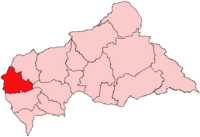Nana-Mambéré facts for kids
Quick facts for kids
Nana-Mambéré
|
|
|---|---|

Nana-Mambéré, prefecture of Central African Republic
|
|
| Country | Central African Republic |
| Capital | Bouar |
| Area | |
| • Total | 26,600 km2 (10,300 sq mi) |
| Population
(2003 census)
|
|
| • Total | 233,666 |
| • Density | 8.784/km2 (22.75/sq mi) |
Nana-Mambéré is one of the 16 prefectures of the Central African Republic. A prefecture is like a large region or state within a country. It helps to organize the country into smaller parts for easier management. The capital city of Nana-Mambéré is Bouar.
Contents
What is Nana-Mambéré?
Nana-Mambéré is a region located in the western part of the Central African Republic. It is one of the main administrative divisions of the country. Think of it as a big district or province. These divisions help the government manage different areas.
Where is it Located?
Nana-Mambéré is in the western area of the Central African Republic. It shares borders with other prefectures. It also borders the country of Cameroon to the west. This location can be important for trade and travel.
How Big is Nana-Mambéré?
The total area of Nana-Mambéré is about 26,600 square kilometers. To give you an idea, this is a very large area of land. It is bigger than some small countries around the world. This vast space includes different types of landscapes.
How Many People Live There?
According to a census from 2003, about 233,666 people lived in Nana-Mambéré. This number tells us how many residents call this prefecture home. The population density shows how many people live in each square kilometer.
The Capital City: Bouar
The main city and capital of Nana-Mambéré is Bouar. This city is the center for many activities in the prefecture. It is where important government offices are located. Bouar also serves as a hub for local businesses and services.
Why is Bouar Important?
As the capital, Bouar is a key city for the region. It is often where people go for markets, schools, and healthcare. The city helps connect the different parts of Nana-Mambéré. It plays a big role in the daily lives of the people.
Geography and Environment
The landscape of Nana-Mambéré is diverse. It includes plains, hills, and sometimes forests. The climate is tropical, meaning it is generally warm all year round. There are also rainy and dry seasons.
Rivers and Natural Features
The prefecture is named after two rivers, the Nana and the Mambéré. These rivers are important for the local environment. They provide water for people, animals, and plants. Rivers can also be used for transportation in some areas.
Life in Nana-Mambéré
Life in Nana-Mambéré is mainly rural. Many people work in farming. They grow crops like cassava, maize, and groundnuts. Some people also raise livestock.
Local Economy
The economy in Nana-Mambéré relies heavily on agriculture. People often sell their crops in local markets. This helps them earn a living. Trade with neighboring areas and countries is also important.
Culture and Traditions
The people of Nana-Mambéré have rich cultures and traditions. These are often passed down through generations. Local customs, music, and stories are important parts of their heritage.
See also
 In Spanish: Prefectura de Nana-Mambéré para niños
In Spanish: Prefectura de Nana-Mambéré para niños

